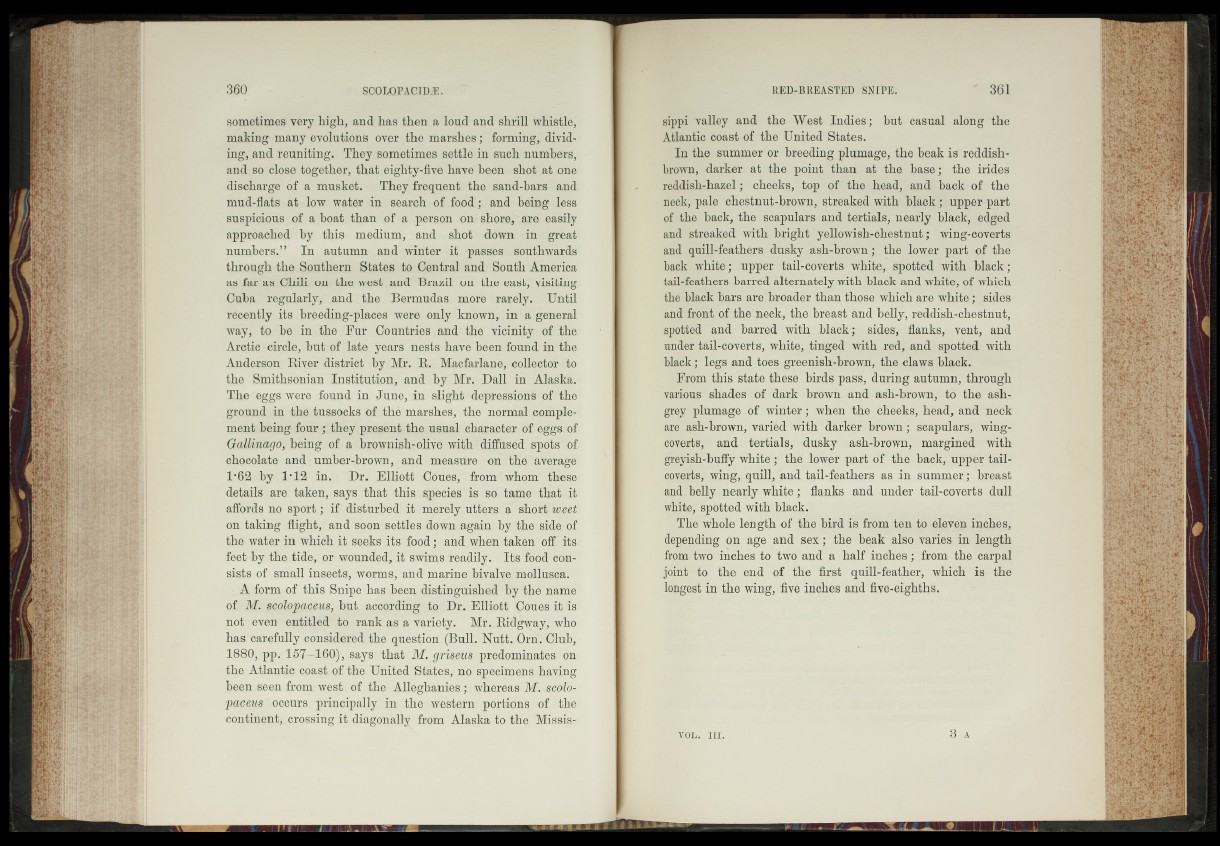
sometimes very high, and has then a loud and shrill whistle,
making-many evolutions oyer the marshes ; forming, divid--
ing, and reuniting. They, sometimes-settle in such numbers,
and so close together, that eighty-five have heen shot at .one
discharge of a musket. •; They frequent the sand-bars and
mud-flats at low water in search of .food"; and being/te'ss
suspicious of a boat than of a person on shore, are easily
approached by this medium, and shot down in great
numbers.” In autumn and winter it -passes southwards
through the .Southern States to Central and South America
as far as Chili on the west and Brazil on the east, visiting
Cuba : regularly, and , the Bermudas mörè ; rarely^ •. 'Until
recently its breeding-places were only known, in a general
way, to be in the 'Fur Countries .and'the vicinity-of the
Arctic - circle, hufeifi late years negts have beemfftahd in the
Anderson River district fby Mr. R. Macfarlane,; collector to
the Smithsonian Institution,' and by Mr. Dali in Alaska.
The eggs were found’in June, in slights depressions of’the
ground in the tussocks of thé marshes, the normal complement
being four ;’they present the usual character of, eggs; of
GaMnago, being of a brownish:olive with diffused, spots’of
chocolate and; umber-brown, and measure,)ilplïhé’ average
1*62 by 1*12 in. Dr. Elliott Cóues, from wlpm'.these
details are taken, says.that-this species is so^ tame that it
affords no sport; if disturbed' i t ;merely h t t ^ a short w]0$r
on taking flight/ and soon settles down again by .the side of
the water in which it seeks-its; food; - and when taken off its
feet -by the^tideV or-wounded, it swims readily. Its food consists
of small insects,s, worms; and marine“bivalve mollusca.
• A form of this Snipe has heen, distinguished J3y¥the name
of ; M. -knt according- jfco Dr.fBf^ptt youes-Tt fg
not even entitled tó -rank as gPvariety. Mj^, Rid gw ay, who
has carefully confid’ered the question (Bull. bJolt- Orn/Cidh}
1880, pp. 157—160), says5that "M. gti§e%s predominates on
th.e Atlantic, coast of the United States, no specimens having
been seen-from wesf/öf the Alleghanies y < whereas Mrssmlö-
pacms occurs-principally in the wèste^nt-pOKtiomsjof the
continent, crossing it diagonally- from Alaska to the Missbb
sippi valley and the West Indies; but casual along the
Atlantic coast of the United States.
In the summer or breeding plumage, the beak is reddish-
brown, darker at the point than at the base; the irides
reddish-hazel; cheeks, top of the head, and back of the
neck, pale chestnut-brown, streaked with black; upper part
of the back, the scapulars and tertials, nearly mabk; edged
and streaked with bright yellowish-chestnut; wing-coverts
and quill-feathers dusky ash-brown; the lower part pf the
back white; upper tail-coverts' ‘white, spotted with black;
tail-feathers barred alternately with black and white, of which
the black bars are broader than those which are whim; sides
and-front of the neek/the breast and belly, reddish-chestnut,
spotted and barred with black 5/ shje.s, flanks, vent, and
under tail-cpverts, white, tinged with red, and spotted with
black ^'legs and toes greenish-brown, the claws black.
From this state these birds pass, during autumn, through
various shades of dark brown and ash-brown, to the ash-
grey plumage of winter; when the oBe^k^jihead, and neck
are ash-brown, varied with darker brown; scapulars, wing-
coverts, - and -^tertials, «dusky ash-brown, margined with
grqvish-buffy white ; the lower part of' the'back, upper tail-
coverts, Wing, quill, and tail-feathers as in summer; breast,
and belly nearly white,;; flanks and under!,tail-coverts dull:
white, spotted with black*
- -^i^e'whole length of the bird isffr^m, Jo eleven inches,
depending on age and sex; the beak also varies in length
from two inches t#t'wo and a half inches'j ’from 'the carpal
joint to the infd" of the first quill-feather, which is "the
longest in the wing, five inches'and five-eighths.
VOL. III. 3 a